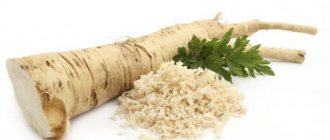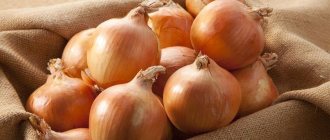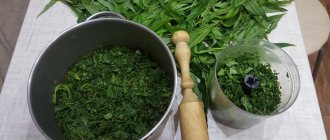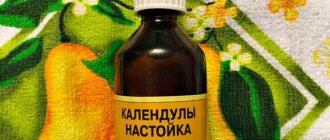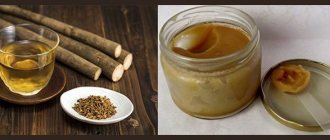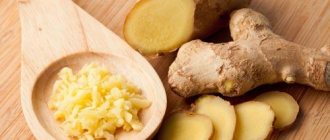Medicinal and beneficial properties of wild Armenian herb aveluk and photos
Horse sorrel has been used as food and as a medicinal plant for many centuries. It is dried, heat treated, infusions and decoctions are made, and used fresh. As a medicine, sorrel is used externally and for internal use. In different places, each people does this in different ways. No matter what form horse sorrel is used, it is always tasty and healthy. Both tops and roots are used, the properties of which are slightly different from each other. Next in the photo you will see what the sorrel itself looks like, as well as the root and seeds of the medicinal herb.
Root
- Preparations from the root act on the body as a fixative and astringent. These properties are caused by the high content of tannins - tannins that cause protein coagulation, which helps protect the surface of the intestinal mucosa. As a result, the secretion of gastric juice is reduced, bleeding is reduced, and the protection of the intestinal walls is increased. Tanning agents also help with the external use of sorrel preparations to treat ulcers and burns.
- Anthraquinone compounds provide a laxative effect to the roots when used in large doses. Anthraquinones act as a stimulant on the large intestine and help soften stool.
- Leukoanthocyanidins and catechins, which are among the many biological compounds of sorrel, have choleretic, antioxidant and hepatoprotective effects.
- It is believed that due to the high content of leukoanthocyanidins and catechins, preparations from sorrel roots have antitumor properties.
- Biologically active substances of both roots and seeds cause anti-inflammatory, antimicrobial, antispasmodic, hypotensive, diuretic, expectorant, hemostatic and sedative effects on the human body.
- Liquid extracts from horse sorrel reduce high blood pressure in hypertension of the first and second degrees.
- A decoction of sorrel root may be useful in relieving symptoms of alcohol intoxication. After taking it, your well-being and mood improve, headaches go away, tachycardia and thirst disappear, and blood pressure decreases. Appetite and sleep improve.
- In Tibet, skin diseases are treated with sorrel root juice.
- Brazilian folk healers use a decoction of sorrel roots externally for inflammation of the lymph nodes and internally to relieve fever, cleanse the body, against scurvy and as a tonic.
- Hindus use the juice of sorrel roots to relieve toothache, and for gum inflammation and to clean teeth they use powder from the root.
- The Thais recommend taking sorrel steam baths for skin ulcers and sore eyes.
- Slovak folk healers recommend drinking a decoction of horse sorrel root for intrauterine diseases and various bleeding that occurs in the lungs, stomach, and intestines.
Seeds
- The fruits have the same properties as the roots; they contain a large amount of tanning substances, catechins, and flavonoids (quercetin, rutin). They have astringent and antioxidant properties.
- Preparations from the seeds are used for dyspepsia and dysentery in complex therapy; some traditional healers use them to treat nail diseases, lichen, scabies and vitamin deficiency.
- Decoctions and infusions of seeds soothe and produce a general strengthening effect.
Collection and procurement of raw materials
Unlike other medicinal herbs, horse sorrel is used entirely for medicinal purposes. In the spring (May, April) the grass is collected, and when the upper part of the plant dries out, it is time to harvest the roots. No special equipment is needed.
Sorrel roots are dug up in the fall, washed thoroughly, and cut into pieces. The prepared pieces are laid out on a sheet of plywood and dried in the open sun, then dried in warm, well-ventilated rooms. An attic or shed will do. It is allowed to prepare raw materials in warm ovens where the temperature does not exceed 35ºC.
The grass is collected during flowering. Large parts are cut lengthwise, small parts are cut into pieces, then the raw material is sent under a shed or into a dryer at a temperature of 40ºC. During the drying process in the open air, so that the medicinal raw material does not rot, it is recommended to turn it over from time to time. The dosage form is ready if the plant can be broken and the cracking sound characteristic of dry grass can be heard.
We recommend reading: Tea with ginger for weight loss - benefits and harm
The leaves of the plant are also collected during the flowering period, which occurs in June-July. Sometimes flowers and seeds are prepared. Dry in the usual way in the sun or in a well-ventilated area. At the same time, all the beneficial properties of sorrel will be preserved.
Chemical composition
The chemical composition of the plant is very diverse. These are macro and microelements, organic acids, various oils and resins, nitrogenous substances, antimicrobial substances, sugars and tanning agents. That is why horse sorrel can be used to treat various diseases of internal organs and external diseases.
Tops contain:
- anthraquinones;
- flavonoids up to 8.15%, including rutin up to 1.4%;
- caffeic acid.
Stems contain:
- fiber 27%;
- nitrogen-containing substances, including proteins up to 12.7%, fats up to 2%;
- iron up to 0.2%;
- tanning agents from 2 to 7%;
- routine;
- a number of vitamins C, K, PP, carotene.
The flowers contain:
- tanning substances up to 8.25%;
- vitamin C;
- routine up to 2.5%.
The grains contain:
- tanning agents from 6 to 7.36%;
- essential oil up to 0.05%;
- calcium oxalic acid up to 1.2%;
- anthracenes, catechins, flavonoids up to 1.6%;
- anthraquinones from 1.08 to 1.22%;
- vitamin C, K;
- carotene.
The roots of the plant contain:
- vitamin K;
- tanning substances of the pyrocatechol group up to 16%;
- ascorbic acid;
- flavonoids;
- essential oils up to 0.2%;
- organic acids;
resins;- anthraquinone derivatives (hrigyufanic acid, emodin, aloeemodin, fiscion).
The chemical composition of the roots includes:
- macroelements in mg/g (calcium – 37.10, potassium 4.70, magnesium – 4.30, iron – 0.70);
- microelements in mcg/g (barium - 22.30, strontium - 5.20, boron - 3.50, selenium - 1.25, copper - 0.64, nickel - 0.60, aluminum - 0.42, zinc - 0.39, vanadium – 0.26, manganese – 0.19, cobalt – 0.16, iodine – 0.09, chromium – 0.07, lead – 0.05).
Oxalic acid calcium is found in large quantities in all parts of the plant.
Indications for use: what are the benefits for humans?
Medicinal compositions from different parts of horse sorrel are used both independently and in complex therapy for many diseases.
They can also be used as prophylactic agents. An important factor is the dosage of the medicinal composition, since in small and large doses sorrel preparations act in different directions. The following diseases can be effectively treated:
- stomach and intestines, such as atonic constipation, enteritis and colitis;
- hemorrhoids, rectal fissures;
- bleeding of various etymologies;
- helminths, salmonellosis in children;
- hepatitis, cholecystitis and cholangitis;
- prevention of vitamin deficiencies;
- diseases of the oral cavity (sore throat, stomatitis, etc.);
- allergies;
- furunculosis, ulcers and burns;
- rheumatism.
Horse sorrel
horse sorrel, frog sorrel, horse sorrel, hernial moth, thick sorrel, wood sorrel, sorrel
Perennial herbaceous plant, meadow weed. In folk and traditional medicine it is valued for its laxative, astringent, choleretic, hemostatic, and antiseptic properties. It is used internally in the form of juice, decoctions, infusions. Externally - in the form of lotions, compresses, ointments.
Name in Latin: Rumex confertus Name in English: Horse sorrel Family: Buckwheat
The medicinal properties of horse sorrel and its contraindications were described by the Persian physician Avicenna. In Rus', they have known about this miracle herb for many centuries. Today it is popular not only in Russia, but also in China, Germany, Uzbekistan, Azerbaijan, and Armenia. In Asian countries, dried herbs are used as a seasoning. Horse sorrel is a high-quality natural dye that can produce a rich palette of shades of brown, yellow, and orange. But still, first of all, the plant is valued for its pharmacological effects. Medical institutions conducted experimental therapy with horse sorrel for patients suffering from constipation, colitis, hemorrhoids, and dysentery. The herb has also been used in patients with hypertension. In both cases, the treatment results were positive.
Contraindications and side effects, possible harm
A side effect of the drugs may be caused by oxalic acid , which is contained in large quantities in the plant. Oxalic acid, when reacting with calcium, can form oxalic acid calcium in the human body, a salt that is poorly soluble in water. It can fall out in the kidneys in the form of sand or sediment and contribute to the formation of oxalate stones.
Horse sorrel and preparations made from it are contraindicated for gout, salt metabolism disorders, kidney disease and predisposition to kidney stones, as well as during pregnancy and breastfeeding. This is due to altered metabolism in the above patients and pregnant women.
Can it be eaten and used in cooking?
Horse sorrel is used for medicinal purposes and for cooking. In Armenia, the leaves along with the stems are collected, dried and only then used for cooking. During drying, the bitterness characteristic of fresh leaves disappears, and they become pleasant to the taste. Dried leaves are used to prepare :
- soups;
- pancakes;
- salads;
- as a filling for pies and pies;
- snack;
- omelette.
The French add sorrel to fricassee and stews. In England, stewed sorrel is consumed with meat or fish. Italians prepare mousses from horse sorrel .
In Russia, first courses are cooked and the filling for pies is made. The most popular dish in the former USSR is borscht made from fresh horse sorrel leaves. Borscht is less sour than regular sorrel and is suitable for dietary nutrition.
Young sour sorrel leaves are frozen, dried or preserved for the winter. At the same time, they retain all the beneficial properties. The leaves can be preserved in salted and pickled form.
Description and distribution
It grows throughout almost the entire territory of Russia, with the exception of the northernmost regions, and is found in meadows, forest clearings, forest edges, near roads, along the banks of reservoirs, especially in damp places - in floodplains, like a weed in vegetable gardens.
Horse sorrel, Rumex confertus L. is a perennial herbaceous plant from the buckwheat family, class dicotyledonous, up to 150 cm in height with a short rhizome and numerous fleshy roots.
The stem is single grooved, branched in the upper part, emerging from a bunch of light green leaves on long petioles. The lower leaves are oblong-heart-shaped, up to 30 cm long and 12 cm wide, wavy along the edge; the upper leaves are smaller, ovate-lanceolate.
The flowers are collected in the upper part of the stems in a thick cylindrical paniculate almost leafless inflorescence, consisting of small greenish-yellow flowers, from which brown, then brown seeds are formed - triangular nuts (like buckwheat), which are eaten by birds and scattered by the wind. Up to 1500 – 2000 seeds are formed on one plant. Under conditions of high humidity, the seeds germinate well, but for a plant grown from a seed to bloom and bear fruit, it takes at least 10 years; it also reproduces quickly by dividing rhizomes.
The grass blooms in May–July, the fruits ripen in June–July and do not fall until winter. The grass is harvested during flowering, rhizomes with roots in the fall, in August - September.
The roots are dug up, washed in running water, trimmed, thick roots are cut, withered and dried, laid out in a thin layer in air or in dryers at a temperature of 50 - 60°C, dried until the roots become brittle. Leaves, fruits with an admixture of flowers are collected and dried in the open air. Raw materials are stored for 3 years.
Treatment: what does it help?
Diarrhea
For diarrhea, a decoction of the plant is used as an independent medicine. Take either freshly prepared or for short-term storage in a cool, dark place. It is important to follow the dosage and use the following recommendations:
- Grind the dried root, add one teaspoon to a liter of water, boil for ten minutes, strain and cool. Drink sixty milliliters in the morning, lunch and evening.
- Pour two tablespoons of dried seeds into two glasses of water and boil for ten minutes. After cooling and straining, adults drink, dividing into three times. Children are given 30-50 milliliters in the morning, lunch and evening.
Haemorrhoids
To treat hemorrhoids, decoction and infusion are used, preferably in complex therapy. Use internally and for enema. The drugs are prepared and used as follows :
- Pour a tablespoon of dried raw material into two hundred milliliters of water, boil for 15 minutes over low heat, let sit for ten, squeeze. Take a tablespoon in the morning, lunch and evening. Recommended for colitis, enterocolitis, rectal fissures. Can be used for enemas.
- An alcohol infusion is made from 5 grams of dry root and 120 milliliters of alcohol. Place the composition in a dark place for two weeks. Strain and take 20 drops before meals in the morning, lunch and evening. Do not use for enemas!
Dysentery
When treating dysentery, it is advisable to use horse sorrel in complex therapy. The most effective is a freshly prepared decoction:
Pour a teaspoon of dried root into five glasses of water, boil for 15 minutes, filter. Drink one third of a glass three times a day.
To strengthen hair
The decoction is used for oily and brittle hair , for split ends and to eliminate dandruff. The cooled broth is heated and rinsed on clean hair using one of two recipes:
- Brew 12.5 grams of dried roots with two liters of water. Leave until cool. Rinse hair after washing.
- Pour four tablespoons of dried horse sorrel leaves and dried burdock roots into a liter of water and boil for 30 minutes, let steep until cool. Rinse washed hair.
Boils
To treat furunculosis, a fat-based ointment is used; it is used simply by applying it to the skin and in the form of bandages. Often when treating furunculosis, blood purification is necessary. The ointment is made and applied very simply:
Mix root powder with animal fat, petroleum jelly or vegetable oil. Can be applied to boils and skin ulcers.
Bleeding
For pulmonary, uterine, and gastrointestinal bleeding, take the infusion. It can also be used for colon fissures. Here is a simple recipe for preparing and taking the tincture :
Pour 5 grams of dried root into 120 milliliters of vodka, leave for two weeks, strain. Drink twenty drops three times a day before meals.
Rheumatism
Rheumatism is treated with sorrel infusions, taken internally, as a rub and in the form of compresses. The process of manufacturing and treatment with tinctures for internal and external use is different:
- Infuse twenty grams of horse sorrel roots in 100 milliliters of vodka for ten days, filter. Take 20 drops in the morning, at lunch and in the evening before meals.
- One fresh root is peeled, cut into small pieces and infused in 0.5 liters of vodka for 20 days. Rub the sore joints twice a day, can be used as compresses.
Blood purification
When a lot of waste and toxins accumulate in the body, the body cannot function normally. This leads to the emergence and manifestation of various diseases, in particular pulmonary, liver, kidney, cardiovascular and allergies.
We clean the blood as follows::
- Pour five tablespoons of root into five glasses of hot water.
- Boil for 10 minutes over low heat, leave for one hour (covered with a towel).
- Before use, strain and take 50 ml 15 minutes before meals, four times a day.
Horse sorrel is very useful due to its chemical composition. The plant contains tanning agents, organic acids, essential oils, flavonoids and vitamins. According to traditional medicine recipes, infusions, decoctions and ointments are made from it. They prepare delicious and healthy dishes. At the same time, do not forget about contraindications, especially for pregnant women and women during breastfeeding.

